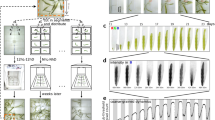Summary
Phototactic responses in a giant amoeboid cell ofPhysarum plasmodium were studied both by analyzing intracellular ATP content and by applying image processing for recording oscillatory changes in thickness with use of a microcomputer. The ATP content fluctuated and deviated from the initial level upon exposure to light with varying wavelength from 400 to 600 nm. The maximum decrease in the integrated value\(\int\limits_{\text{O}}^{\text{T}} {{\text{ATP}}}\) dt with T=9 minutes occurred at the wavelength 450 nm. The ATP in a migrating plasmodium distributed twice as high in the front as in the rear. This polar pattern became unstable, and a new wavy pattern appeared by stimulating a local frontal part with blue light. In a concentrically extending plasmodium, peripheral and inside regions oscillated in opposite phase to each other. When part of this organism was exposed to light, stimulated and unslimulated regions began to oscillate in opposite phase, and phase waves propagated inward the stimulated region. And the protoplasm there became thinner, the strongest avoidance reaction occurring to 450 nm light as in ATP response. Phototactic behavior inPhysarum is discussed in terms of bifurcation in spatio-temporal organization appearing in a self-organizing system.
Access this article
We’re sorry, something doesn't seem to be working properly.
Please try refreshing the page. If that doesn't work, please contact support so we can address the problem.
Similar content being viewed by others
References
Akitaya T, Hirose T, Ueda T, Kobatake Y (1984) Variation of intracellular cyclic AMP and cyclic GMP following chemical stimulation in relation to contractility inPhysarum polycephalum. J Gen Microbiol 130: 549–556
Baranowski Z (1985) Consequences of impeding in mitochondrial functions inPhysarum polycephalum. III. Reversible cessation of the contraction-relaxation cycle and the temperature sensitivity of the alternate respiratory pathway. Europ J Cell Biol 39: 283–289
—,Shraideh Z, Wohlfarth-Bottermann KE (1982) Which phase of the contraction-relaxation cycle of cytoplasmic actomyosin inPhysarum is modulated by blue light? Cell Biol Intern Rep 6: 859–865
Field RJ, Burger M (1985) Oscillations and traveling waves in chemical system. John Wiley & Sons, New York
Garrison PN, Barnes LD (1980) Cyclic AMP in the cell cycle ofPhysarum polycephalum. Biochim Biophys Acta 636: 114–121
Häder D-P (1985) Role of calcium in phototaxis ofPhysarum polycephalum. Plant and Cell Physiol 26: 1411–1417
—,Schreckenbach T (1984) Phototactic orientation in plasmodia of the acellular slime mold,Physarum polycephalum. Plant and Cell Physiol 25: 55–61
Hato M, Ueda T, Kurihara K, Kobatake Y (1976) Phototaxis in true slime moldPhysarum polycephalum. Cell Struct Funct 1: 155–164
Hess B (1983) Non-equilibrium dynamics of biological processes. Hoppe-Seyler's Z Physiol Chem 364: 1–20
Kamiya N (1959) Protoplasmic streaming. Protoplasmatologia 8: 1–199
Korohoda W, Schreideh Z, Baranowski Z, Wohlfarth-Bottermann KE (1983) Energy metabolic regulation of oscillatory contraction activity inPhysarum polycephalum. Cell Tissue Res 231: 675–691
Matsumoto K,Ueda T,Kobatake Y (1986) Propagation of phase wave in relation to tactic responses by the plasmodium ofPhysarum polycephalum. J Theor Biol: in press
Meinhardt H (1982) Models of biological pattern formation. Academic Press. London
Nicolis G, Prigogine I (1977) Self-organization in nonequilibrium systems. John Wiley & Sons, New York
Rakoczy L (1980) Effect of blue light on metabolic processes, development and movement in true slime molds, p 570 (The blue light syndrome).Senger H (ed). Springer. Berlin Heidelberg New York
Satoh H, Ueda T, Kobatake Y (1984) Rhythmic contraction in the plasmodium of the myxomycetePhysarum polycephalum in relation to the mitochondrial function. Cell Struct Funct 9: 37–44
Ueda T, Kobatake Y (1980) Contraction rhythm in the plasmodium ofPhysarum polycephalum: dependence of the period on the amplitude, temperature and chemical environment. Europ J Cell Biol 23: 37–42
—,Matsumoto K, Akitaya T, Kobatake Y (1986) Spatial and temporal organization of intracellular adenine nucleotides and cyclic nucleotides in relation to rhythmic motility inPhysarum plasmodium. Exp Cell Res 162: 486–494
Watanabe M, Furuya M, Miyoshi Y, Inoue Y, Iwahashi I, Matsumoto K (1982) Design and performance of the Okazaki large spectrograph for photobiological research. Photochem Photobiol 36: 491–498
Wohlfarth-Bottermann KE, Block I (1981) The pathway of photosensory transduction inPhysarum polycephalum. Cell Biol Intern Rep 5: 363–373
Yoshimoto Y, Sakai T, Kamiya N (1981) ATP oscillation inPhysarum plasmodium. Protoplasma 100: 159–168
Author information
Authors and Affiliations
Rights and permissions
About this article
Cite this article
Mori, Y., Matsumoto, K., Ueda, T. et al. Spatio-temporal organization of intracellular ATP content and oscillation patterns in response to blue light byPhysarum polycephalum . Protoplasma 135, 31–37 (1986). https://doi.org/10.1007/BF01277050
Received:
Accepted:
Issue Date:
DOI: https://doi.org/10.1007/BF01277050



